Foundation of the Navy Nurse
Corps
.
The United States Navy Department was established
in 1789.
Only twenty years later, Navy Surgeon Cutbush
was the first Navy official to suggest using women for Navy nurse tasks
to higher authorities. He did not remain the only one with this opinion
in the following years. Especially, wives and widows of seamen were considered
as possible nurses.
Nevertheless, it took another hundred years
until the Navy Nurse Corps was founded. |
... |
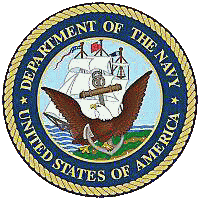 |
.
Female Pioneers
.
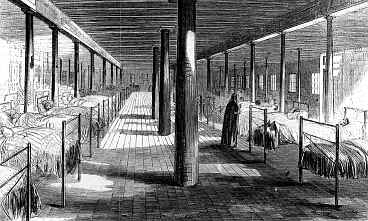 Scene in the ward of the USS Red Rover
(1862-65)
Scene in the ward of the USS Red Rover
(1862-65)
.
.Nuns
of the Holy Cross Nursing Sisters served on the Red Rover used as U.S.
Navy hospital ship during the Civil War.
|
.. |
However, women worked as nurses aboard Navy
ships and Navy hospitals long before the Navy Nurse Corps was established
in May 1908. These women offered their help during wartime whenever the
need for nurses was especially urgent. The first nurses served on a Navy
ship during the War of 1812. Again, during the Civil War and later during
the Spanish-American War several women performed nurse duties for the Navy.
They performed this duty in places that were often dangerous and required
much courage. |
.
The Public Law
.
Finally, at the beginning of the 20th Century,
the Surgeon General of the Navy, Rear Admiral Rixey, formally requested
establishment of a female Navy Nurse Corps. He reasoned that the general
opinion of the Bureau of Medicine and the doctors is that women are the
better of the trained nurses and those Navy hospitals would benefit from
their employment. In 1901, the Congress already had established an Army
Nurse Corps (female) as a permanent corps of the Army’s Medical Department.
However, two bills regarding the foundation of a Navy Nurse Corps (the
first one introduced in 1902 and the other one in 1904) failed to pass
the Congress.
.
Rixey continued to plead for a women’s corps
as an urgent necessity and the most economic solution for the lack of proper
nurse functions within the Navy. The nurses would be especially valuable
for training the hospital corpsmen in their special duties. As a
result, such personnel would be better prepared for their service aboard
ships or on distant stations. Eventually in May 1908, another brief bill
requesting the establishment of the U.S. Navy Nurse Corps passed the Congress
and was signed into law by President William Howard Taft.
.
The public law that established the Navy
Nurse Corps stated:
.
| “The Nurse Corps (female) of the
United States Navy is hereby established, and shall consist of one superintendent,
to be appointed by the Secretary of the Navy, who shall be a graduate of
a hospital training school having a course of instruction of not less than
two years, whose term of office may be terminated at his discretion, and
of as many chief nurses, nurses and reserve nurses as may be needed: Provided,
that all nurses in the Nurse Corps shall be appointed or removed by the
Surgeon General, with the approval of the Secretary of the Navy, and that
they shall be graduates of hospital training schools having a course
of instruction not less than two years. The appointment of superintendent,
chief nurses, nurses, and reserve nurses shall be subject to an examination
as to their professional, moral, mental, and physical fitness, and that
they shall be eligible for the duty at naval hospitals and on board of
hospital and ambulance ships and for such special duty as may be deemed
necessary by the Surgeon General of the Navy. Reserve nurses may be assigned
to active duty when the necessities of the service demand, and when on
such duty shall receive the pay and allowances of nurses: Provided,
that they shall receive no compensation except when on active duty. The
superintendent, chief nurses, and nurses shall respectively receive the
same pay, allowances, emoluments, and privileges as are now or may hereafter
be provided by or in pursuance of law for the Nurse Corps (female) of the
Army.” (public law 115, SIEXTIES Congress, Session I, Chapter 116, 1908,
p.146.) |
.
The Superintendent
.
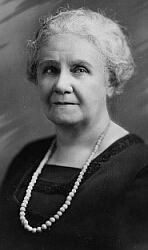
.
Esther Voorhees Hasson
First Superintendent of the Navy
Nurse Corps, from 18 August 1908 to 10 January 1911.
|
.. |
Ms. Esther Voorhees
Hasson (then 41 years old) was appointed as superintendent. She was especially
qualified for the position because of her extensive experiences as a nurse
in civil and military life. She had served as an Army contract Nurse before
the Army Nurse Corps was established in 1901; she had worked as an Army
Nurse and as a civil service nurse. She had served in the Philippines,
on the Isthmus of Panama and on the hospital ship Relief. |
.
However, in 1911 Miss Hasson, who had set
the important leading standards of the Nurse Corps, resigned as superintendent.
She had continuous problems working with Surgeon General Stokes who had
become Surgeon General in 1910.
.
Her successor was Mrs. Lenah Sutcliffe Higbee.
To the relief of both parties, Mrs. Higbee was able to develop a more amicable
relationship with Surgeon General Stokes. |
.. |
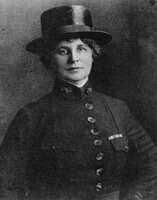
.
Lenah H. Sutcliffe Higbee
Second Superintendent of
the Navy Nurse Corps, from 20 January 1911 to 30 November 1922.
|
.
First Navy Nurses
.
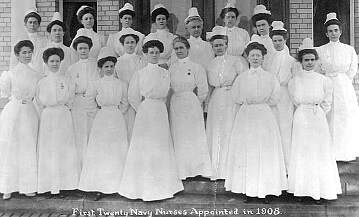 .
"The Sacred Twenty" .
"The Sacred Twenty"
|
.. |
The requirements for the applicants set a
high standard and created an elite corps.
.
In October 1908, the corps consisted of an
initial nucleus of 20 nurses: 1 superintendent, 2 chief nurses and 17 nurses.
These women will later be known as the “Sacred Twenty”. Many of them had
previous experience with the military serving as Army contract nurses and
Army Nurses before joining the Navy Nurse Corps. |
.
For several weeks, the nurses received general
and special instructions to familiarize them with the naval service. Their
job not only required excellent nurse abilities, but also a lot of administrative
work. After their orientation period was completed in March 1909, the nurses
received their assignments to Naval hospitals within the United States.
Three more chief nurses were appointed among them. Chief nurses had additional
responsibilities and received more pay. The nurses had no officer’s ranking
nor enlisted rating, but in almost every way they were treated like officers.
.
These women did a tremendous job as pioneers.
At first, they had to face many prejudices of male naval personnel who
were concerned about women working in a sphere considered as distinctly
male. However, they were able to prove their worth and soon became highly
respected members of the Navy.
.
| Navy Nurses posing in front of
the U.S. Naval Hospital, Philadelphia, Pennsylvania, 1914. |
.. |
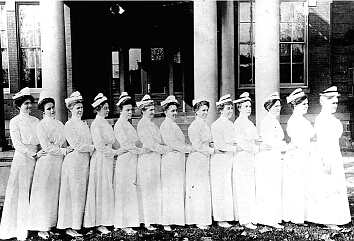 |
.
Some of the initial problems these nurses
experienced started with the lack of individual quarters. Usually, they
had to search for private accommodation somewhere nearby the Navy stations.
Another problem was the payment. For example, sometimes they did not receive
adequate allowances for the extra efforts spent on private quarters, and
chief nurses were denied the pay of Chief Nurses while on leave or when
traveling. Some controversy involved the home care for Navy dependents.
At first, the nurses were asked to volunteer for this job in their off-duty
time, but soon it turned out to be expected from them regularly.
.
Serving Overseas
.
Some Nurses did brief
service on board ships. In 1913, Navy Nurses served abroad the USS Mayflower
and the USS Dolphin
 USS Mayflower (1898-1931)
USS Mayflower (1898-1931)
.
 USS Dolphin (1885-1922)
USS Dolphin (1885-1922)
|
.. |
Already in 1910, Navy Nurses received their
first overseas assignments to the Naval Hospital at Canacao in the Philippine
Islands. In the following year, Navy Nurses were sent to the new duty station
at Guam in the Marianas Islands. Beginning in 1913, Navy Nurses also served
Tutuila, Samoa.
.
By the way, these Pacific stations were coaling
stations for Navy ships. Back then the Navy was dependent on coal power,
and coal had to be stored at depots around the globe, in order to get
the ships across the ocean and back.
. |
.
A special task of the nurses serving overseas
in the Pacific area was to build up training schools and instruct native
women.
In the exotic surroundings these nurses were
confronted with diseases and injures (like strange animal bites) completely
unknown to them. Often they had to work under very difficult conditions
and had to do a great job in improvising.
.
Strength of the Navy Nurse
Corps,
1908-1916
.
| Year... |
Numbers |
| 1908 |
20 |
| 1909 |
37 |
| 1910 |
54 |
| 1911 |
86 |
| 1912 |
110 |
| 1913 |
130 |
| 1914 |
135 |
| 1915 |
155 |
| 1916 |
152 |
.
(The numbers for the statistic
were derived from the Bureau of Naval Personnel
Annual Report, Navy and Marine
Corps Military Personnel Statistics, 30 June 1960.)
.
.
[ I. Development ] [
II. Facts about the NNC ] [ III. Uniforms
] [ IV. Sources
]
|
